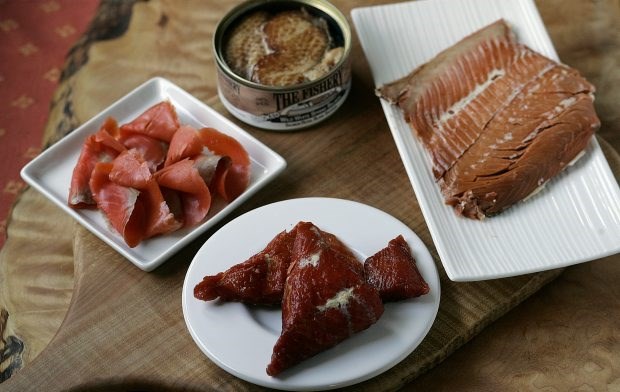Q. How long can you keep vacuumpacked smoked salmon on your shelf, or does it need to be frozen? I see it on shelves in airports all the time, not refrigerated. I get my salmon prepared professionally and it comes frozen. I have asked this question numerous times and have never got a clear answer.
Doug Lacey
A. The best way to answers Doug's question is to describe the different types of smoked salmon.
At grocery and seafood stores you'll see cold smoked salmon for sale. It's most often sold vacuumpacked in plastic and frozen, or thawed from frozen, either already thinly sliced, or sold in whole fillets.
To make it, raw salmon is brined, which enhances the salmon's flavour and texture and provides preservative and antiseptic properties. The fish is then smoked at cool temperatures, around 21 C to 32 C, which helps preserve the salmon's fine colour. When ready, the fish will have an almost raw look, feel slightly firm and have an appealing, silky texture.
Cold smoked salmon is sometimes labelled lox, but most guides say "true" lox is brined in a much saltier solution and is not usually smoked.
If you've bought thawed from frozen cold smoked salmon, it will keep a few days refrigerated.
For the best taste, though, devour soon after purchasing.
Another type you'll see for sale is hot smoked salmon, which, in retail settings, is usually sold fresh.
At some stores, and at seafood companies processing fish for recreational fishermen, the hot smoked salmon is also frozen in vacuumed-sealed bags.
Like cold smoked salmon, the raw fish is flavoured with a brine marinade that, along with salt, could include things such as sugar, spices and other flavourings. The fish is then smoked and fully cooked at higher temperatures ranging from 49 C to 82 C.
Hot smoked salmon is much firmer than cold smoked salmon, looks like it has been smoked and can be separated into coarse flakes.
Ashley Flannigan, spokesman for Hardy Buoys Smoked Fish in Port Hardy, says at the time their fresh, hot smoked salmon gets shipped, it has a 14-day shelf life. Stores selling it should be able to tell you when they received it and what the best-before date is.
If you don't think you'll eat it all, Flannigan says fresh hot smoked salmon could be frozen for up to a month.
The airtight, vacuumsealed frozen product noted above will keep for many, many months.
Other forms of hot smoked salmon include candied salmon, which is sweetly flavoured with such things as honey, maple syrup or brown sugar.
Smoked salmon is also canned, which can be used as you would regular canned salmon.
Now, on to the smoked salmon product Doug's been seeing at airports. On their website, seachangecanadiangifts.ca, one seller of it, Saltspring Island's SeaChange Canadian Gifts, describes it as fillets of raw salmon prepared with smoke and seasonings.
The fillets then are individually placed in gold foil pouches, also known as retort pouches. The pouch is sealed and cooked with high-temperature steam under pressure.
The resulting product inside the pouch is fully cooked and contains some juice. Like canned salmon, the contents of the pouch are completely sterile and extremely shelf stable.
Seachange says you can store its product, without refrigeration, for three years from the production date.
Once the pouch is opened, refrigerate any leftovers and use within five days.
This product is popular with tourists as they can pack it in their bags and not worry about refrigerating it. That explains why you see it for sale at airports and other touristy places.
The smoked salmon Doug is receiving is obviously not processed this way as it would not be frozen, it would be packed in a box filled with pouches he could store at room temperature.
SMOKED SALMON, LEEK AND CORN CHOWDER
This hearty, smoky chowder will make a fine lunch or dinner if served with crusted bread. Any of the forms of smoked salmon noted in today's story could be used in this recipe.
Preparation time: 20 minutes
Cooking time: About 30 minutes
Makes: 6 servings
3 Tbsp butter or vegetable oil
1 medium leek, white and pale green part only, halved lengthwise, washed and sliced
2 medium celery ribs, finely chopped
1 garlic clove, finely chopped
3 Tbsp flour
3 3/4 cups chicken stock or clam nectar
1/3 lb (150 grams) smoked salmon, chopped or flaked into small pieces
2 medium red-skinned potatoes, cut into small cubes
1 cup fresh for frozen corn kernels
1 bay leaf
1/2-1 tsp dried tarragon
1 cup light cream or milk
- white pepper to taste
Melt the butter, or heat the oil, in a pot set over medium heat. Add the leek, celery and garlic and cook until tender, about 5 minutes. Sprinkle in the flour, mix well, and cook 2 minutes more. Slowly stir in the stock or clam nectar. Bring to a simmer, and then reduce the heat to a gentle simmer. Add the smoked salmon, potatoes, corn, bay leaf and tarragon and cook until the potatoes are tender, about 10 to 15 minutes.
Stir in the cream or milk and heat through a few minutes more. Season the soup with white pepper. (The smoked salmon should have given it enough of a salty taste.) Ladle into bowls and enjoy.
- Eric Akis is the author of the best-selling Everyone Can Cook series of cookbooks. His columns appear in the Life section Wednesday and Sunday.
If there is a cooking issue that has you scratching your head, send your question to Eric by email at eakis@timescolonist. com, by fax to Ask Eric at 250-380-5353 or by regular mail to Ask Eric, Times Colonist, 2621 Douglas St., V8T 4M2
eakis@timescolonist.com



